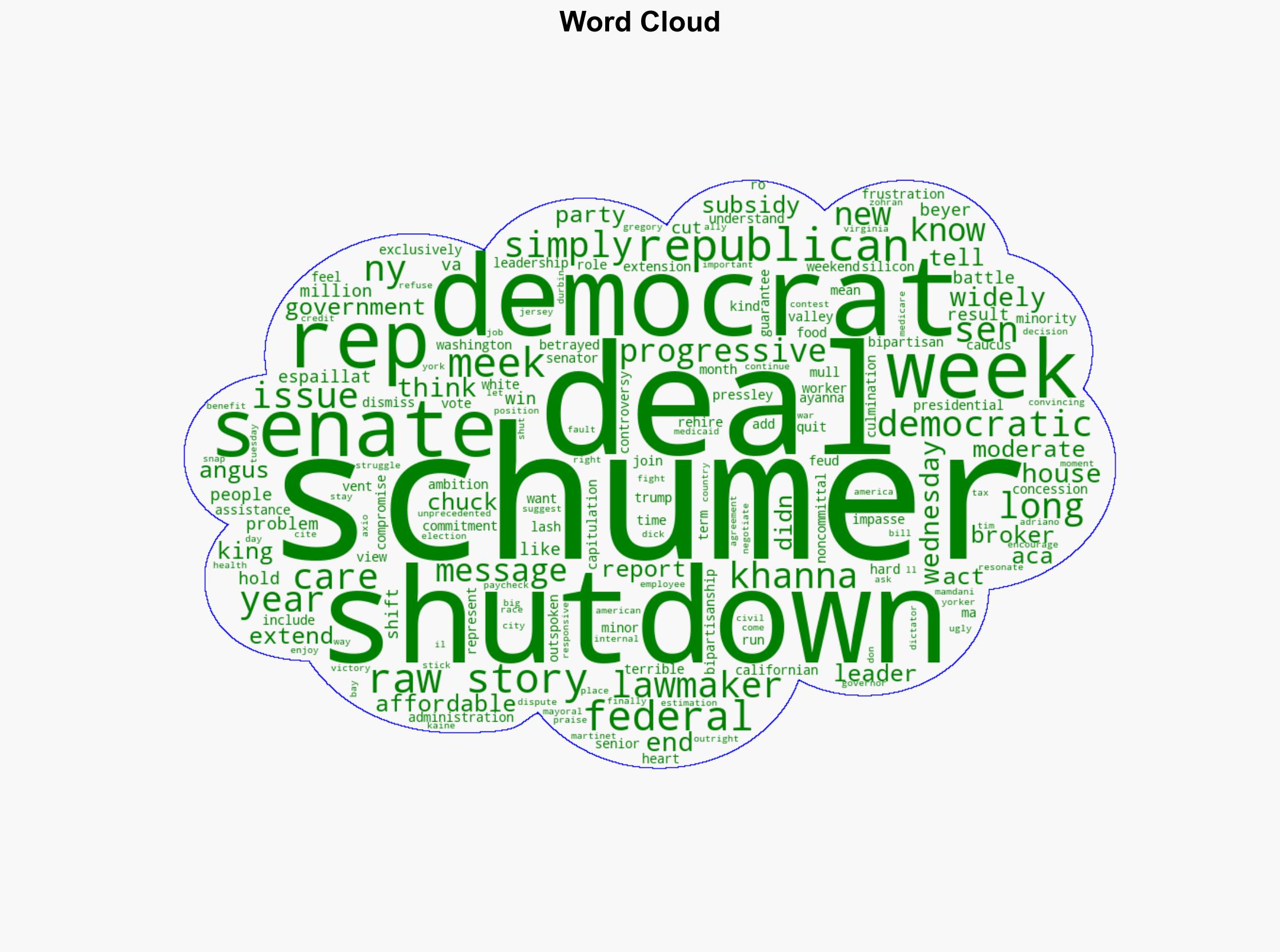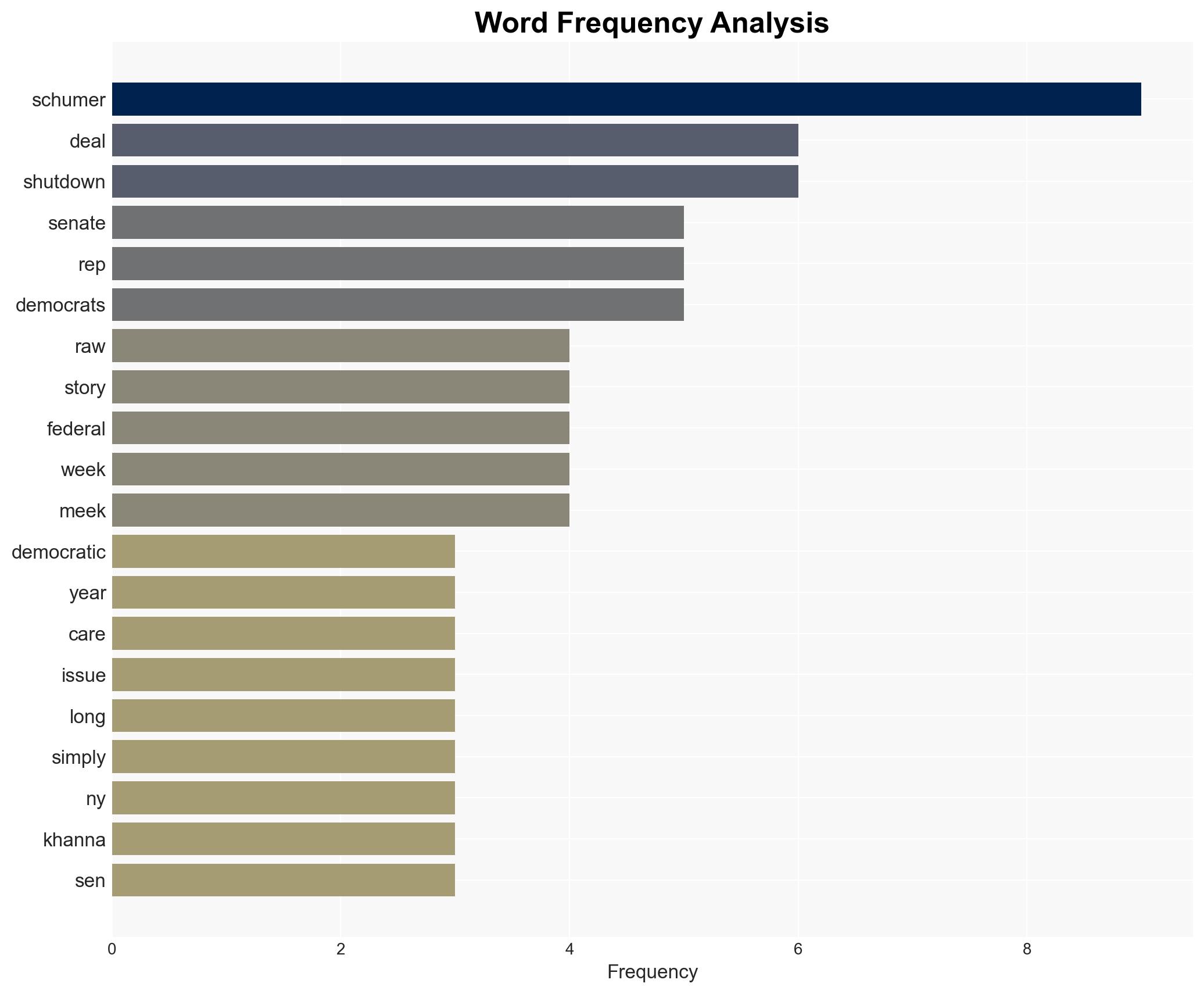‘Terrible capitulation’ Top Dem rages as progressive ‘feud’ with Schumer boils to surface – Raw Story
Published on: 2025-11-13
AI-powered OSINT brief from verified open sources. Automated NLP signal extraction with human verification. See our Methodology and Why WorldWideWatchers.
Intelligence Report: ‘Terrible capitulation’ Top Dem rages as progressive ‘feud’ with Schumer boils to surface – Raw Story
1. BLUF (Bottom Line Up Front)
The current discord within the Democratic Party, particularly between progressives and moderates, is a significant internal challenge. The most supported hypothesis is that this internal conflict could weaken the party’s cohesion and effectiveness in future legislative negotiations. Confidence Level: Moderate. Recommended action includes fostering dialogue between factions to unify the party’s strategy and messaging.
2. Competing Hypotheses
Hypothesis 1: The feud between progressives and moderates, exemplified by the criticism of Chuck Schumer, is a temporary issue that will resolve as the party unites against common Republican opposition.
Hypothesis 2: The feud represents a deeper, more enduring division within the Democratic Party that could undermine its legislative agenda and electoral prospects.
Assessment: Hypothesis 2 is more likely given the intensity of the rhetoric and the strategic differences highlighted. The lack of significant concessions in the recent deal exacerbates existing tensions.
3. Key Assumptions and Red Flags
Assumptions: It is assumed that the Democratic Party’s internal divisions are primarily ideological rather than personal. Another assumption is that the public perception of these divisions could impact voter confidence.
Red Flags: The public airing of grievances and calls for leadership changes suggest a lack of internal conflict resolution mechanisms. The involvement of potential presidential candidates like Ro Khanna indicates strategic positioning rather than mere policy disagreement.
4. Implications and Strategic Risks
The primary risk is the potential for reduced legislative effectiveness, which could lead to a loss of voter support in upcoming elections. This internal discord may also embolden Republican opposition, potentially leading to more aggressive policy stances and legislative gridlock. Additionally, the perception of a divided party could be exploited in information campaigns by political adversaries.
5. Recommendations and Outlook
- Facilitate a series of internal dialogues and workshops aimed at reconciling differences and developing a unified strategy.
- Enhance communication strategies to project unity and a coherent policy agenda to the public.
- Best Case Scenario: The party resolves its internal differences, leading to a stronger, unified front in future legislative battles.
- Worst Case Scenario: Continued infighting leads to significant electoral losses and an inability to pass key legislation.
- Most Likely Scenario: The party experiences ongoing tensions but manages to maintain enough cohesion to advance a limited legislative agenda.
6. Key Individuals and Entities
Chuck Schumer, Ro Khanna, Ayanna Pressley, Adriano Espaillat, Gregory Meek, Don Beyer, Tim Kaine, Angus King, Dick Durbin.
7. Thematic Tags
National Security Threats, Political Cohesion, Legislative Strategy, Electoral Politics
Structured Analytic Techniques Applied
- Cognitive Bias Stress Test: Expose and correct potential biases in assessments through red-teaming and structured challenge.
- Bayesian Scenario Modeling: Use probabilistic forecasting for conflict trajectories or escalation likelihood.
- Network Influence Mapping: Map relationships between state and non-state actors for impact estimation.
Explore more:
National Security Threats Briefs ·
Daily Summary ·
Methodology





